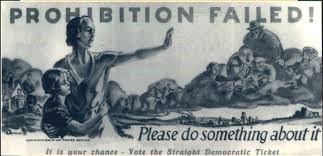
The United States Constitution guides the federal government and American citizens with a framework of rules believed to be the best for our nation since 1789. Over the years amendments have added or ceased certain issues facing our country. The first ten amendments detail rights of citizens from oppression of the federal government, better known as the Bill of Rights.
The remaining seventeen amendments address issues that have arisen since 1789. Most limit the federal government in certain ways. However, two amendments strike at citizens of the United States. The first of these is the 13th Amendment that abolished slavery.
The 18th Amendment has an unusual history. It denied Americans the right to manufacture, transport, or sell intoxicating beverages and became dubbed Prohibition. At the time of ratification, the United States was involved in World War I, hostilities between immigrants and native-born citizens created animosities, and Progressives intended to clean up the morals of all Americans. By 1919 the 18th Amendment was ratified and went into effect January 1920. Most Americans followed the new law somewhat enthusiastically as they embraced the consumer society that developed. But gradually intoxicating liquors appeared on the list of consumer society must haves.
As the demand for liquor, beer, and wine increased, the Mafia sponsored rum running and “speakeasies” to meet the demands. More widespread than organized crime was the ones who simply made moonshine, a grain-based hard alcohol and whiskey that had long been popular in rural areas. People began to mix drinks creating new flavor combinations. Some concoctions led to illness or death. Where men had spent time in saloons before Prohibition, men and women gathered in speakeasies.
Americans seemed like caged animals unleashed in the 1920s. The end of World War I, a very different war from the earlier Civil War, gave everyone a sigh of relief. New commercial publications set off a new culture of American values. Readers wanted to know about sports and sex. Distilled drinks, hip flasks, cocktail parties intrigued the nation. The automobile changed the economy from a steam age to a gasoline age.
Both federal and local authorities had not a clue how to curtail society. Feelings of over-extension of the federal government jarred the nation. Enforcement of laws could not be financially supported. Violence occurred in big cities and small towns. Cruises to nowhere took customers out of the U. S. territorial waters to enjoy liquor and lavish foods before turning back to the states.
Suddenly the stock market bubble burst, recovery didn’t return as expected. A complete way of life disappeared at the end of Post-War 1920s. Poverty and unemployment took the place of parties and gaieties. Drastic changes in the U.S. affected the public mind. Yet, it took almost a year for everyone to realize this wasn’t a temporary problem. What was the solution?
Finally, on February 20, 1933, just before Franklin D. Roosevelt was sworn into office, Congress introduced the 21st Amendment to end Prohibition with the Repeal of the 18th Amendment. For the first time in 140 years, Congress voted to repeal an amendment. To this day, no other amendment has been repealed. On November 24 of that year, Texas ratified the repeal. Those counties, towns, and other entities who voted dry prior to the ratification of the 18th Amendment were still dry in 1935. Utah, the 36th state to ratify the 21st Amendment, the one needed to formally repeal, and close Prohibition.
